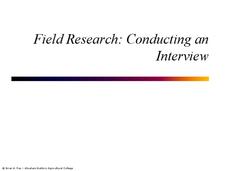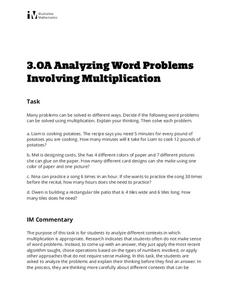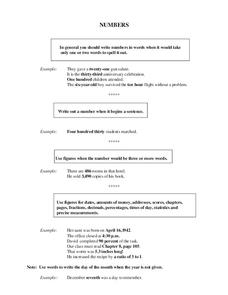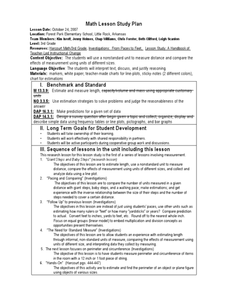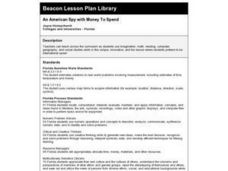Curated OER
Electricity
Cute cartoons and diagrams help explain electric charge to your physical science buffs. No math is involved even though units for electric charge and voltage are mentioned. This is a pretty neat and straightforward note taking guide for...
Curated OER
Field Research: Conducting an Interview
Go through the proper steps to setting up and conducting an interview as part of research. Slides detail preparation, materials you should have, and follow-up procedures. Specific questions for the interview are not suggested but the...
Curated OER
Analyzing Word Problems Involving Multiplication
Learners sometimes have difficulty making sense of a word problem. In a guided learning activity, pupils are asked to think about how to find an answer and explain their thinking, rather than finding the answer. It allows them to...
Curated OER
Linear Inequalities in Two Variables
Use this worksheet as a warm up, a refresher exercise, or a practice after a more detailed lesson on graphing linear inequalities in two variables. Start with boundaries that are horizontal or vertical, then move into graphs with...
National External Diploma Program Council
Numbers
The written form for 345 is three-hundred forty-five, where as the word form for 70% is seventy percent. Here, young mathematicians read 10 sentences and write the word form of each number in the sentences.
Discovery Education
Sonar & Echolocation
A well-designed, comprehensive, and attractive slide show supports direct instruction on how sonar and echolocation work. Contained within the slides are links to interactive websites and instructions for using apps on a mobile device to...
Curated OER
Rules of Exponents
Students solve problems involving exponents. Through a teacher led discussion, students explore the rules of exponents and create cards with "x's" on them. Given a division problem, students lay out "x's" to represent the numerator and...
Curated OER
Thermometers Rising
Third graders read a Fahrenheit thermometer from an actual thermometer. In groups, they are provided with ink pads and a thermometer stamp. They use the stamps on plain white paper and use red pencil to take the temperature readings.
Curated OER
Mother May I?
Third graders measure distance using nonstandard units of measure. In this measurement lesson, 3rd graders measure a given distance through the use of the game "Mother May I?" Student gather and compare data on how many "giant steps" and...
Curated OER
Which Is the Better Car Deal?
Learners investigate whether it is more economically sound to take a low financing rate or rebate when purchasing a car.
Curated OER
Geo Jammin' - Day 6, Lesson 20: Hail, Hail, the Gang's All Here
Students use shape puppets to review geometry content. They take turns singing songs, reading students poems, reciting class bulletin board notes and choral poems. They prepare for their summative assessments through play and interview...
Curated OER
Classroom Triangles
Students use bearing measurements to triangulate and determine objects' locations. Working in teams of two or three, students must put on their investigative hats as they take bearing measurements to specified landmarks in their...
Curated OER
Making It All Add Up!
Students use technology resources for problem solving. They complete math problems or integrated science problems dealing with math concepts using an online calculator.
Curated OER
Times Tables Cards
In this math activity, students cut out 110 multiplication cards. The cards include the question and answer for times tables one through ten.
Curated OER
Sandlapper Solutions
Students use mathematical thinking and reasoning to translate problems into mathematical language and thereby solve the problems. They extend their understanding of whole number operations to fractions and decimals by participating in...
Curated OER
Surprise Snack
Students prepare a simple recipe and engage in a surprise math lesson. They enjoy making a class book featuring their favorite recipes, and can host a party with members of the school staff once their snacks are prepared.
Curated OER
An American Spy with Money To Spend
Sixth graders use their imagination, math, reading, computer, geography, and social studies skills in this unique, innovative, and fun lesson where students pretend to be international spies!
Curated OER
Apples A"Peel" To Me
Second graders study the characteristics and uses for apples through this series of ten lessons. They look at the importance of apples in the US. They read literature about apples, graph, sort, and measure apples, and make apple snacks....
Curated OER
Speaking and Listening
In this basic mathematics worksheet, students follow instructions as given to play a math game. They listen for detail in explanations and narratives in various contexts. Students also provide feedback and confirmation of what they...
Curated OER
Crazy Putty Ratio
Second graders use knowledge of measurements and ratios to mix various combinations of liquid starch and glue. They chart their ratios, make observations, and write a summary of the activity. They mix their own batch of Crazy Putty to...
Curated OER
Critical Thinking Strategies
Students explore critical thinking strategies. In this critical thinking lesson, students evaluate multiple choice answers. Students note similarities between incorrect answers and discover how to compare and contrast incorrect and...
Curated OER
Here's Looking at You
High schoolers assess some common inherited traits which are easily observable and note their phenotype for the trait. Students compare their phenotypes to those of their parents and attempt to describe the pattern and manor of inheritance.
Curated OER
Discovering a Law of Space Physics
Learners use data collected by an astronomer to determine the relationship between the time it takes the planet to orbit the sun and the average radius of the planet's orbit around the sun. Students use trial and error to find the...
Curated OER
How Many Strips?
Second graders investigate the measurement of 1 meter. They predict and measure how many strips of paper it takes to make exactly one meter. Students devise and use problem solving strategies to solve the problem.



